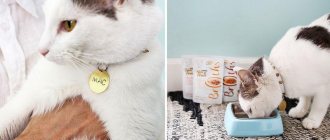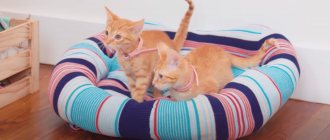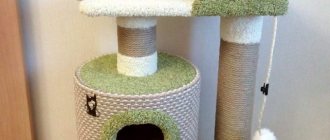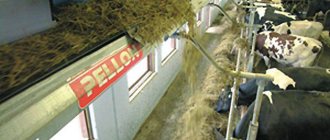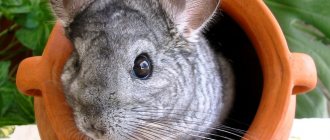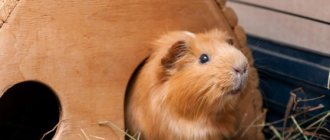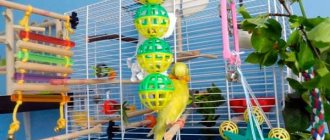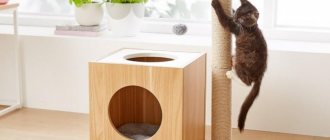What is a harness
The harness is part of the equipment: this way the owner can control a cat of any breed and size while walking. The product is also used as a leash, and common materials and types of fabrics are used in the manufacture of harnesses: nylon, fleece, cotton, leatherette, velor and even knitted materials.
The harness is suitable for “cat” travel
Angel Wings or how to sew a harness for a cat - step by step
Does a cat need walks? Every pet owner decides this question independently. It will be useful for your pet to take a walk outside, walk on the grass, breathe fresh air, and feel the beauty of life.
But letting a cat go unattended on the street is dangerous: the animal can get hit by a car, get scared, run away, or fall into the wrong hands. Therefore, for safe walks, it is recommended to wear a cat harness on your pet when walking.
Of course, you can purchase a harness for a cat, or you can make it yourself, at minimal cost. How to quickly and easily sew a harness for a cat with your own hands - as easy as shelling pears! We invite you to sew a leash for your cat with your own hands with detachable wings.
Difference between a harness and a collar
When choosing between a collar and a harness, it is necessary to take into account the anatomical features of the animal. Both accessories have characteristic features that will help you make the right choice.
- The classic collar is convenient to use, but the design of the collar is always the same and can easily turn it into a stranglehold: when talking about cats, you should remember that these are small and fragile animals. When walking, when the animal makes sudden movements, the collar will put pressure on the animal’s neck and vertebrae, which can harm the cat’s health.
IMPORTANT: a tag with the pet’s name and the owner’s phone number is placed on the collar in case the animal gets lost.
The collar is increasingly used as an identification element
- The advantage of a harness is that it distributes the load on the pet’s body, making it comfortable for walking, traveling and going to the veterinarian. The downside is that with age, the harness may become small and pets do not always agree to wear such equipment.
The harness is firmly fixed on the animal’s body and does not put pressure on the cervical vertebrae
IMPORTANT: breeders of cats and small dogs often prefer harnesses; this choice is less traumatic for the structure of small animals. Collars are more effective in handling medium and large breeds of dogs; in this case, the collar does not harm the animal’s spine.
How to choose a model and size
Don't rush to purchase the product right away. The ideal option would be to buy a harness with your pet, but if this is not possible, pay attention to the following nuances:
- the optimal material is cotton or nylon, the fabric will not rub the animal’s body and get very dirty;
- 1.5 centimeters is the ideal width of the straps, since a wider version will restrict the pet’s movements, and a narrower one will rub and tighten;
- fastenings should be easy to unfasten and fasten - this guarantees the durability of the device;
- Is there a mechanism for attaching a leash?
If you come shopping with your pet, be sure to try on the harness you like on your cat. Whether it fits or not can be determined by inserting 2 fingers between the strap and the back of the animal. If your fingers were able to pass freely, then the choice was made correctly.
The choice of harness model for a cat depends on its size and, oddly enough, temperament. If the cat is large or restless, buy a reliable option - a vest or V-shaped harness. For calm and small pets, figure-eight or H-shaped modifications are suitable.
A leash is immediately purchased in the kit; it is connected to a special ring and reaches a length of approximately 2 meters. You can find a leash of a different length or buy a tape measure. The last option is suitable for those who have chosen a vest-style harness for their pet, already equipped with fasteners. But be careful: you shouldn’t walk in the heat in a vest.
Some models are made to make the cat look fashionable - they are decorated with rhinestones, ornaments, and pendants. Such accessories are suitable for participating in various competitions and creating original photos, but they are not always convenient and safe for the animal. Therefore, choose elegant harnesses and leashes for your cat with caution.
Types of harnesses
Harnesses allow you to walk your pet without causing any inconvenience to it. High-quality models fit tightly to the animal’s body, do not hinder its movements and evenly distribute the load on the pet’s skeleton. At the moment there is a wide range of shapes and colors. However, do not rush to purchase a harness without consulting a specialist and without trying the product on your pet. This will help you understand which accessory your pet feels most comfortable in.
- Figure-of-eight harness. This is a lightweight accessory that consists of loops, one of which is put on the neck, and the second on the torso. The advantage of the model is that it has fasteners that allow you to adjust the size of the product.
The “figure eight” is fixed in the neck and chest area
- V-shaped harness. This model is considered classic and is distinguished by the junction of the loops, which is located under the animal’s chest.
V-shaped harness securely fastens in the chest area
- Harnesses-overalls. Simply put, this is a common clothing option for pets that protects them from the cold and parasites. The model is equipped with a loop to which a leash is attached.
Harness-overalls are suitable for the cold season
- Harness in the shape of the letter "H". In the model, two loops are combined using a strap and worn similarly to a figure-eight harness. The model does not hinder the movement of the animal.
The model differs from the first one by the presence of a strap in the abdominal area
- Harness-vest. The product is a vest that is worn on the upper part of the animal’s body and allows you to evenly distribute the load on the pet’s body.
The vest significantly shifts the load to the center of the body
IMPORTANT: the harness must match the size of the pet, it should not pinch the animal’s body and neck.
Buy or make it yourself?
Leashes for cats today can be bought at any pet store or online store, and you can also order inexpensive models from China. These products have a size chart, some of them are even equipped with an adjustment system: if the purchased harness is slightly too big for your pet, you can tighten the straps.
The stores offer a wide range of harnesses made from different materials: these can be leather or fabric straps, elastic nylon bands, suede and fleece models. Additionally, leashes with a length of up to 3 meters are purchased for the products, allowing the freedom-loving pet to calmly explore a new territory under the supervision of the owner.
But not all cats are suitable for purchased harnesses - standard products may not be the right size, and then the money will be wasted. In addition, these pets perceive new odors quite negatively, especially for products from China.
We suggest you read: Why cats love boxes and adore bags
Sometimes even several washes do not help rid the product of the specific aroma that furry pets sensitively sense. The best option is to make a cat harness with your own hands, or even better if you make this accessory from your own worn-out items.
Your familiar smell coming from used fabrics will reduce the stress of wearing new clothes for your animal.
Similar leashes for cats are sold in every pet store. The most suitable for cats are models made of nylon elastic tape with a soft felt lining. The material should be very light, since cats have sensitive skin.
Although most models have straps that can be adjusted, it is best to know the circumference of your cat's neck and chest in advance so that you can take these parameters into account when choosing a product.
Today you can find the following options on sale:
- harnesses for kittens;
- accessories for large cats;
- universal leashes;
- reflective harnesses;
- products made of suede and nylon.
- These are Chinese harnesses with a leash. Such an accessory is not suitable for big cats, since a large animal with well-developed muscles can tear the product.
If the animal does not like conventional harnesses, which come with several straps, it is worth trying products that resemble overalls. Most cats wear it calmly. At the same time, the possibility that the pet will get caught somewhere is excluded.
The cat will need a long leash. It should be 2-3 meters long, so the cat can calmly explore the territory that interests it. Many owners choose roulette leashes, which are used for walking small dogs.
How to make a harness with your own hands
The question “how to make a harness for a cat?” involves a simple process. The potential difficulty is to accustom the cat to the product, for which at the manufacturing stage it is necessary to take into account:
– material: it must be dense, but not rough, otherwise there is a risk of discomfort and even injury; for this you can use denim, thick rope, or knit from yarn;
– age: for the first time, for older pets, use simple types of harnesses; it will be easier for an adult cat to get used to equipment with a minimum of details;
– time of year: overalls and vests are used in cold seasons; in summer, the use of such equipment can cause overheating;
– width of the straps: optimally, if the width of the straps is 15 mm maximum – such an accessory will not cause inconvenience to the pet and will not look bulky;
– leash length: 2 meters long is enough for walking, and for additional adjustment you can use a special carabiner;
Homemade harnesses are no less popular
IMPORTANT: you will leave your scent on the homemade product, which will be a plus in teaching an adult cat to the item.
Taking measurements from a cat
To take measurements, you will need the girth of the cat's neck and chest. To make more complex models, the distance between the paws and the length along the back are required.
IMPORTANT: to be on the safe side, add 5 mm to the result - this will avoid pinching the product.
In this video you will learn how to correctly take measurements from a cat - this will help you sew not only harnesses, but also clothes for your pet
X-shaped harness (figure-of-eight harness)
This is the simplest and most popular type of harness to make. You will need: a strap made of soft material (10-15 mm), measuring tape, scissors, needle, thread, buttons (or plastic fasteners) and a ring.
- First, prepare the necessary measurements: neck and chest.
- Based on these data, cut 2 strips from the strap, leaving 2 cm on each.
- Fasten the blanks at the intersections with buttons (if there are no buttons, you can sew the blanks together with thread or make jumpers for plastic fasteners).
- At the intersection of the parts, sew a ring to which a carabiner for the leash will later be attached.
- For a more precise fixation, sew a strap along the belly.
The model is easy to manufacture; materials can be found at hand.
H-shaped harness (vest)
The peculiarity of the product is that the load falls on the pet’s chest. The following will help you make it yourself: a nylon (or cotton) piece of fabric - 2 cm, braid, measuring tape, thread, needle, scissors, buttons (or plastic fasteners) and a ring for attaching a carabiner.
- You will need measurements of the animal: neck circumference, chest, distance between paws.
- Draw a pattern on a piece of paper and transfer it to the fabric, then you can cut out the blank.
- Sew the fabric along the entire length.
- On the blank, in the area of the bent ends, make blanks for buttons or jumpers for plastic fasteners.
- A braid is sewn along the back, onto which a ring for a carabiner is attached in the future.
- If you wish, you can use decorated details (appliques, beads).
The vest is more difficult to make, but allows you to show more originality
Harness
This type of harness securely secures the animal; the product differs from the H-harness by an additional strap under the animal’s chest, so the model can be made according to the same principle.
This video is popular among cat lovers, has many positive reviews and clearly demonstrates the making of a decorated harness
How to make it?
First, let's look at the simplest leash for cats and figure out how you can make it yourself. It is very easy to put on, since the collars themselves are not solid, but are attached with Velcro and carabiners.
Cat walking on a leash
First you need to decide what material you can use to make a collar for a kitten. These can be leather or nylon straps, medium-diameter rope, fabric strips, especially denim. Further materials and tools will be the same for everything.
- Leather strap 1 m long;
- Velcro 2 pieces;
- Carbine;
- Leash;
- Centimeter or tape measure;
- Scissors and chalk;
- Needle and thread and awl.
Our collar will consist of three parts, or rather strips of different lengths. But to do this, you need to take measurements from the kitten. It will be difficult to cope with this task yourself, so one person should hold the pet, the second should take measurements.
- Three measurements are made. One around the neck, the second somewhere in the middle of the chest. When measuring, be sure to insert 2 fingers between the centimeter and the cat, so the kitten will be more comfortable and comfortable. We also measure the distance between the neck and the chest strap, this will be the third measurement.
- Three blanks are cut from a long strap. To do this, add 2 cm to the measurements that were taken.
- Now you need to mark with chalk the middle of two large harness blanks and sew to these marks the smallest strap, which will subsequently be on the cat’s back. Where the needle cannot cope, you can make a puncture with an awl. The result should be a shape resembling the letter “H”.
- Then Velcro is sewn onto the ends of the straps that will be worn around the neck and back. A carabiner for a leash is sewn onto the middle bar. The cat leash is ready.
Harness-vest for walking
Many women embroider collars with rhinestones, stones, and sew bows. There are craftswomen who suggested sewing something like a vest onto this base. To do this, they make a pattern with their own hands and from fabric - a blank, which, in turn, is sewn into the inside of the harness.
Harness patterns for cats
Measurements for cutting a harness
An example of a cat harness pattern
How to knit a harness for a cat - this question may be relevant for needlewomen, since with the help of knitting skills you can also make an original and unique decoration for your cat. The product will be comfortable for your pet: use threads made of hypoallergenic material (usually aricl or natural cotton fabrics), do not use synthetic dyes. In this process, all you need is measurements, rings for fastenings, threads, a hook or knitting needles. The process will take some time, but it will certainly be a memorable accessory for your pet.
An example of a knitted harness for a cat or small dog
When a cat harness comes to the rescue
A cat harness comes to the aid of owners who plan to take their pet out of the house to the street or to an unfamiliar place. A design with a collar and leash is used to keep the animal within sight, prevent it from running far, hiding in a secluded place unknown to the owner, or climbing a tree, from where it will be extremely difficult to get it out.
Harnesses are used for both kittens and adult pets, the only difference is in size. A cat leash will be useful at exhibitions or when visiting a veterinary clinic - with it the animal will be under the full control of the owner, not immobilized, but safe.
Features of making ammunition for kittens
The principle of making harnesses for kittens is practically no different from the process of making equipment for adult cats. Instead of denser fabrics, you can use softer ones - fleece, cotton, velor.
Kittens quickly get used to everything new
After completing the vaccination, you can start training your cat for walking - let him play with an object, smell it, even sleep. Do this until the baby gets used to it and stops responding to the harness. In the future, a mature kitten will calmly react to changes in equipment and will not be afraid of the street or walks.
In what cases is it prohibited to lead a cat on a harness?
A cat on a harness has the opportunity to walk outside - this is a definite plus. However, not all cats need walks, and sometimes they are completely contraindicated.
Cat harnesses themselves do not pose a danger to the animal - except in cases where there are severe wounds or sores on the skin. Leash straps can rub the sore spot, delaying healing and causing infection. Therefore, you should not walk with your pet until the wounds on the skin have healed completely.
Walking, with or without a leash, is contraindicated in several cases:
- During the period of heat, it is better to refrain from leaving the house.
- After serious operations or injuries, according to the veterinarian, it is necessary to reduce the number of walks or abandon them altogether.
- In the absence of vaccinations, it is better not to take the cat outside or to the dacha - a pet with low immunity can easily contract a dangerous disease, even if it just sniffs a blade of grass.
- Until the kitten reaches the age of 5-6 months, it is better to refrain from walking.
- If a cat is terrified of the street, there is no need to force it to walk - many mustachioed cats are content with walking on the balcony or looking at the outside world through the window.
The list goes on for a long time; There are several reasons for refusing to go for walks. If your cat doesn't feel well or wants to sleep on the sofa, you shouldn't give him a walk - this will bring extra stress.
How to put a harness on a cat
Adult pets do not always readily respond to changes; for this reason, it is advisable to accustom your cat to walking from an early age.
- First, let your pet get acquainted with the object and smell it. There is no need to immediately pick up the cat and put on equipment. Some owners leave the product next to the pet overnight so that it can painlessly get used to the new item. It is advisable to give this as much time as necessary until the cat begins to calmly accept the harness.
Adult cats are distrustful of anything new, so first leave the cat and the object in the same room for a while
- Prepare the equipment so that you can immediately insert the cat's paws into the holes and you do not have to fuss around trying to hold the animal.
- Carefully pick up the cat, preferably on the floor or soft sofa. Don't make sudden movements. Try to communicate affectionately with the animal, praise and treat in the process.
- Quickly, but with smooth and precise movements, put the harness on the animal's body.
- Fasten the harness straps and place the animal on the floor.
IMPORTANT: after the process, let your pet stay in the harness and walk around the house/apartment with it a little. When the animal gets used to it, you can attach a leash to the harness and take it for a walk indoors. Once you get comfortable, you can walk your pet in a calm, deserted place where there are no concentrations of other animals.
Video demonstrates the process of putting a harness on an adult cat
How to put on a leash if your pet resists
Practice shows that some cats quickly get used to the harness, and after two days they are ready to go outside, while other wayward cats resist for a long time and do not allow this accessory to be put on them. How to accustom an animal to a new thing? How to wear a harness if the cat is categorically against it?
It is important to remember that you should never try to put on a harness or leash using brute force! Your pet will simply be afraid of this thing and will not allow you to try again for a very long time.
You need to gradually accustom such an animal to a harness. For several days you should put it on with very smooth and calm movements. You can do this while the cat is napping. Having put on the accessory, you need to take the fluffy one in your arms, lightly stroking it and saying all those kind words to which the animal is accustomed.
At first, it is enough for the cat to stay in the new thing for a short time, but gradually you need to increase the time spent in the harness and leash. If your furry pet continues to resist, you can try to put on the accessory together, without using force, only lightly holding the cat by the paws and body. After the procedure, you need to pet your pet and feed him something tasty.
Nylon harnesses
They are much lighter than leather or leatherette. Moreover, they are the most durable and durable, and are not inferior to products made from other materials. To sew a fairly comfortable item for your pet, you first need to decide why you need it in the first place:
— for a harness (a nylon model without buckles and rings, as well as with buckles and a fastening cable, is appropriate here).
Hand-Made Scheme
To get a beautiful harness, follow these steps step by step:
Step 1. Prepare a measuring tape, a large sheet of paper, a pencil, scissors, fabric, braid for finishing, threads, needles, pins, a metal half-ring for attaching a leash, fasteners or Velcro, as well as elements for decorating the finished product.
Step 2. Take measurements of your beloved pet as shown in the photo:
Step 3. Using the diagram on paper, draw a pattern and cut it out.
Step 4. Before transferring the pattern to the fabric, check the dimensions of the pet again, taking into account the length of the harness along the back.
Step 5. Fold a suitable piece of fabric in half along the grain thread. The fold line will be the center of the future clothing and the attachment point for the ribbon with the ring for the leash.
Step 6. Using the paper form, draw two blanks on the fabric.
Step 7. Cut out the drawn parts with a seam allowance of no more than one centimeter. Where one pattern will be the top side of the harness, and the other will be the lining.
Step 8. Sew the braid with a ring along the center line of the front piece, and then fold the two parts on top of one another, facing inward, and sew the product around the entire perimeter, taking into account the seam allowance.
Step 10. Turn the product inside out and iron it.
Final step: decorate the harness with the prepared decorations. And the handwork is ready!
Weights for harnesses
A harness with weights for dogs is only necessary for large and strong animals, such as fighting or service animals. The accessory is recommended in case of acute shortage of the required loads for the breed to restore the lack of muscle mass. This thing is ideal for training endurance in medium and large animals.
However, a harness for dogs with weights cannot be sewn for animals under one year old, because their backbone is still in the process of formation. Otherwise, you can seriously harm the dog and not benefit.
In general, increased strength loads are very useful for some breeds: pit bulls and Staffords, pit bull terriers and Rottweilers, shepherd dogs, etc. For such powerful animals, they came up with different methods of strength training. It has been proven by veterinarians and researchers that a weighted harness is simply necessary for dogs that are deprived of physical activity for some reason. And this kind of accessory with a load, dragged by dogs, should definitely be used by owners who want to see their dog healthy and strong. Walking and training with a weight harness helps you quickly gain weight, correct back arches and strengthen the hock joint.
Leather harnesses
To work with a service dog, it is better to sew a leather product with strong and wide buckles and straps. You just need to make sure that the rings are well soldered and the straps are stitched properly to get a strong harness for the dog. Any pattern you like will do.
You can also make a combined model: from leather and nylon, so it will be lighter and cheaper. When purchasing buckles and rings, also do not hesitate to check for quality.
Why does a cat need a collar, leash or harness?
Even the most phlegmatic domestic cats are happy with the new experiences that a walk gives. And if your pet has an active temperament or has lived on the street in the past, he may feel sad, sitting in the apartment all day long. In order to make walking with your cat safe and comfortable, special devices come to the rescue: a collar, a leash and a harness.
Walks give cats many new experiences
Collar
Some owners purchase anti-parasitic collars for their cats, which the pets even wear around the house. But for a walk you need a more reliable collar with a strong clasp.
If your cat walks, as the saying goes, on its own, you need to choose a comfortable collar for it that will not allow the animal to get caught on protruding dangerous objects and will not fly off during active movements. In addition, the collar must have a mount for an address book on which you can write the cat’s name, your phone number or address. If the pet gets lost or gets into trouble, the people who find it will be able to return the poor thing home. When deciding to walk an animal on its own, you need to be aware that it is unsafe.
The pet's collar must have a tag with the owner's number on it.
An option in which you can not worry about your pet, but at the same time give him the joy of a walk, is to use a collar in tandem with a leash.
Leash
As mentioned above, a leash is the key to a safe walk with a cat. It is best to opt for a long but strong leash. A chain, unlike dogs, is not suitable for cats - it is heavy and can scare your furry or cause him pain.
The cat's leash should be soft and light
And, of course, even when walking on a leash, put a tag with contacts on your cat’s collar - just in case.
Harness
What should you do if your mustachioed pet refuses to walk on a leash and doesn’t like the collar? It doesn’t matter, you can replace these devices with a harness. It looks like an interweaving of wide straps that cover the chest, part of the back and paws.
As a rule, this object irritates cats less and causes less pain when moving, because the throat is a sensitive part of the body of any living creature. When wearing a harness, most of the load falls on the chest, not the neck. And in case of danger (an approaching dog, falling into a hole), it is much easier to grab the pet by the back strap of the harness than to pull the leash.
Most cats enjoy being walked on a harness rather than on a leash.
My cats (both those who came into the house as babies and former street residents with experience) love walks in the fresh air. However, they absolutely do not like harnesses. Animals fall on their stomachs or sides, refuse to move and even lose interest in walking. The situation is completely different when pets are wearing a collar and an ordinary leash. Cats behave appropriately, move along the ground, sniff the grass, albeit with some caution. Perhaps it's because my cats live with dogs and see them walking on leashes. I don’t see any other reason for preferring this accessory to a harness. If it were not for the silent but expressive protest of the cats, I would prefer to walk them on a harness.
Harness-vest for cat Angel Wings
This original Angel Wings harness is sewn according to a simple pattern from old jeans. You can also use any natural fabric: satin, flannel, raincoat, corduroy, cotton, flannel, and so on. Knitwear is well suited for these purposes.
The volume of the vest should correspond to the size of the cat. There should be a gap of 1 finger between the vest and the cat’s body - no more and no less. If the vest is wider, the cat will simply free itself and slip out of it.
To work you will need:
- The jeans are old.
- Pencil and paper for making patterns.
- A metal ring for a leash (like a key ring).
- White fabric for wings.
- Sew-on buttons – small and larger (large buttons can be replaced with buttons).
- Scissors, thread.
- Stuffing for wings (cotton wool, padding polyester).
- Centimeter.
These measurements need to be taken from the cat before making a pattern for work. For example, in this case it is: neck girth – 26 cm, girth under the paws – 37 cm, back length – 12 cm.
On the pattern, the dotted line is the length of the back. At the ends of the “tails”, increase the width of the buttons + 1 cm. Don’t forget that the pattern is given without seam allowance!
We calculated and made a paper pattern for the vest and wings. We take our old jeans and apply the pattern to the wrong side of the fabric. We trace the pattern with a felt-tip pen, adding 1 cm allowance around it. Cut out the part. Then there are 2 options: the first option is to make a vest without lining, the second option: to make a vest with lining, in which case we will need two of these parts.
Markings were applied to the fabric and cut out, departing 1 cm from the intended line.
Cut carefully, leaving 0.3-0.5 cm to the hem (denim) seam.
The edges can either be glued or hemmed by hand using a bias or buttonhole stitch. There can be many options here: you can cut out a strip of denim 4-5 cm wide, sew it and turn it inside out, you can cut out a part of the grosgrain ribbon from which you will make a leash. One thing is clear - this strip must be 5 cm longer than the back of the vest - this is necessary for the loop for the ring.
We bend the edges to the wrong side by 1 cm and baste them.
If the vest consists of two parts, fold them front to front and stitch them, departing 1 cm from the edge, leaving 3 cm of unstitched space (for turning). Turn it inside out and iron it. If the vest consists of one piece, sew it manually or on a machine, departing 0.5 cm from the edge.
We also sew on large buttons with threads matching the color of the product.
Take a piece of white fabric, apply the wing pattern and trace it. The pattern is given without seam allowance, so we add 0.7 cm to the intended line. and cut it out. Let's make another similar detail.
Sew, departing from the edge 0.7 cm. Leave an unstitched area of 3-4 cm for turning.
We stuff the wings with cotton wool or padding polyester. Sew up the remaining hole using a blind stitch.
We attach the wings to the button, thread the ring into the loop. The harness is ready.
How to sew a harness for a dog - just like for a cat. This harness model is also suitable for small dogs.
In the video, a DIY cat harness made from jeans:
In the video, a do-it-yourself Velcro harness for a cat:

